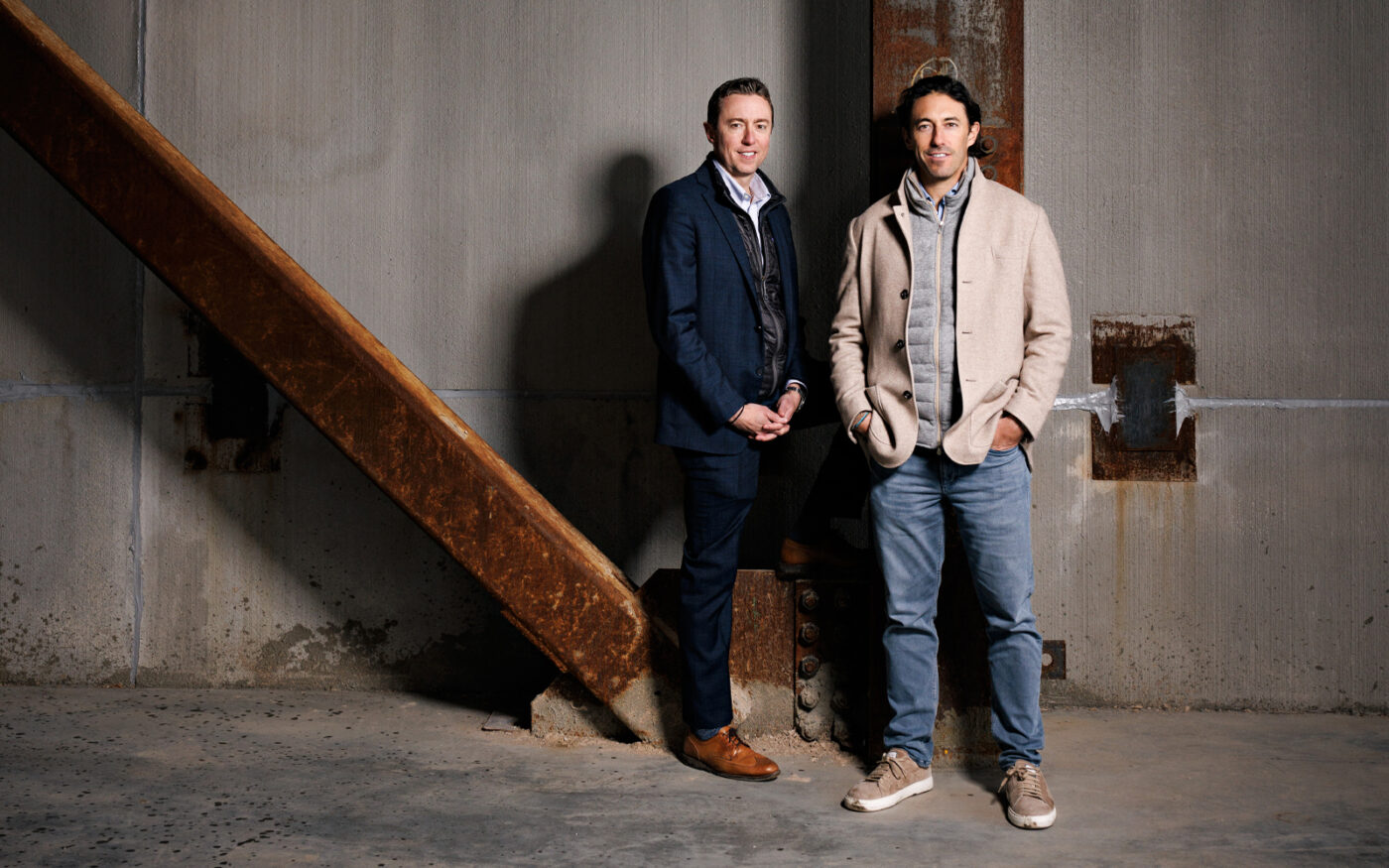How Turnbridge Equities built a $2B portfolio in under a decade
An inside look at the asset class-agnostic player’s grand ambitions

Most developers are either cowboys or suits. Andrew Joblon is somewhere in between, like a pair of Gucci cowboy boots.
Since founding Turnbridge Equities in 2015, Joblon has amassed a $2 billion-plus portfolio through a mix of chutzpah and calculation that brings to mind both the mavericks who built our modern skylines and the financial wonks who increasingly control them.
His company defies pigeonholing, too. As Turnbridge has grown, it has remained asset class-agnostic, building logistics centers, hotels, offices, multifamily and retail with equal zeal. Joblon and his partner, Ryan Nelson, cut their teeth at old-guard New York real estate firms but are taking distinctly modern approaches to structuring deals.
Joblon, who tends to oversee the business’ sexier projects, hails from Dartmouth, Massachusetts, a town of 34,000. Not that he stays low-key anymore — his dog has 20,000 Instagram followers. Nelson, who brings an industrial bent to the firm, grew up on a cattle and hog farm in Nebraska. Getting dirty isn’t an issue for a man who has literally castrated pigs.
The two met just before the Great Recession, when Joblon was working for New York real estate dynasty Fisher Brothers and Nelson for Sherwood Equities, a firm that had amassed a major portfolio in what is today known as Hudson Yards. As transplants working for storied New York firms, they began a business courtship, learning the rhythms of dealmaking in a turbulent city at one of its most turbulent moments.
By 2014, Joblon was hungry for bigger game, but opportunities were limited at a family-owned shop.
“Ultimately, I wasn’t a Fisher,” he said. “It was time to move on and forge my own path.”
Solopreneur
Joblon founded Turnbridge and headed to South Florida. Nelson, whose wife was pregnant, wasn’t yet ready to take the leap, and instead left Sherwood to work industrial deals with MRP Realty.
Joblon wears his long, dark hair swept back down to the base of his neck, with light stubble and a year-round tan. He enunciates with a slight lilt, somewhere between a New England accent — he graduated from blue-blood prep school Tabor Academy — and surfer-chill. On Instagram, his 200,000 followers mainly see pictures of his wife, the Australian actress Claire Holt, and their children. He favors trucker hats and logoless T-shirts, though on the occasions he puts on a suit, he looks like he could be cast opposite her.
In the early years, Joblon had to source high-net-worth backers for every single deal. Many chase charisma, but he had it in spades. That came in handy when convincing wealthy people he could make them wealthier.
The firm’s first deal was characteristically complex: With a high-net-worth backer he found through his brother, Joblon vacated 17 retail tenants and secured zoning incentives for an entire city block in Miami Beach. He later sold the parcel at Sixth and Washington to former Vornado CEO Michael Fascitelli and Eric Birnbaum, who along with David Grutman built the Goodtime Hotel on it.
“Guys, do you want all these areas to stay old and decrepit?”
Ryan Nelson, Turnbridge Equities
“For the first few months, I couldn’t make a decision without calling the 10 smartest people I knew to ask them if I was making the right decision,” Joblon said of his lone-wolf status. “When you’re at a place like Fisher Brothers, they have so much infrastructure around you. I was pretty surprised at the holes in my knowledge.”
Joblon came to Austin in the mid-2010s. It is a cliche to say that the city has transformed, and no one street captures that transformation quite like South Congress, which in its current iteration is a place largely of Joblon’s creation.
The neighborhood first gained relevance in the 1970s, when local band manager Eddie Wilson and his self-declared “loose committee of hippies” opened a music venue called Armadillo World Headquarters. Willie Nelson first played the ‘Dillo in 1972 and soon bought his own venue in South Congress, the Austin Opry House.
Alas, the hippies couldn’t hold it together. The Armadillo closed in 1980, and the area became known for boutique shops and spunky courtyard hotels. When Joblon arrived, there were just two national tenants on the entire shopping strip.
“Our thesis was Austin doesn’t have its iconic street like the rest of the cities of its size,” Joblon said. “We thought if we could obtain some critical mass there that we could have something special.”
Turnbridge started by purchasing roughly 3 acres on the strip, not far from where South Congress Bridge crosses the river. That land is now the centerpiece of what Turnbridge calls Music Lane, a 163,000-square-foot complex of modern mixed-use buildings. Designed by Lake Flato Architects, it is a prime example of the New South architecture that is sweeping Sun Belt cities from Raleigh to Phoenix. No more than four stories tall, the buildings are partial to red brick cut with gleaming glass panels. The upper levels feature balconies with funky sun screens and high-top tables, giving off the vibe of bars, not workplaces.
The ground-floor retail caters to Austin’s new moneyed, athleisured elite: Hermes, Rag & Bone, Equinox, Lululemon, Le Labo and Sweetgreen are some of the tenants that together take up more than 1,700 feet of frontage. Above them lie offices for Deloitte, Gensler and McKinsey & Company, full of people likely to patronize those places.
The whole thing is anchored by a Soho House, which Joblon brought in through a personal connection early in the development process. He kept the news quiet, though.
“Our goal was to buy everything we could around it,” he said.
In 2017, Turnbridge bought CityView Apartments, a garden-style development on more than 5 acres to the north of Music Lane. Around that time, Joblon tried to buy another apartment complex off-market, this one just south of the development and owned by TIAA.
TIAA ended up listing the property anyway, but Turnbridge was the highest bidder because it could see higher returns. The other potential buyers were only planning apartment plays, while Turnbridge wanted to add commercial buildings akin to how it had at CityView.

A key source of construction funding was Austin tech pioneer Michael Dell, whose MSD Capital joined the project with $85 million in equity in 2017.
Local and national investment has since poured into the area. Endeavor Real Estate Group is planning a six-tower redevelopment at the former site of the Austin American-Statesman, one of the biggest projects in city history. At the same time, Related Companies is beefing up its presence on the block.
The assemblage, which came together in four years, is something Turnbridge hopes to replicate in growth markets across the country. It sees Nashville’s 12 South as the next Music Lane.
Juicing up
As the Music Lane deal was wrapping up, Joblon made two decisions that leveled up Turnbridge. He brought in Nelson to run the business with him, and they launched the company’s first closed-end investment fund.
“In the past, we had to pick up the phone and raise the money before we could do anything and go hard [contract],” Joblon said.
If you want to test yourself for megalo-phobia — a fear of large objects — Turnbridge has just the place for you. The Bronx Logistics Center, under construction at 920-980 East 149th Street, is one of the largest permitted buildings in New York City, 1.2 million square feet of raw logistical potential. According to Turnbridge, a car leaving the Bronx Logistics Center can reach Manhattan in five minutes, Queens, Brooklyn or New Jersey in 15 minutes, and Westchester or Connecticut in less than 30 minutes.
During a visit in February, it took 2 minutes and 36 seconds just to walk from one end of the building to the other.
Turnbridge started the assemblage with the biggest piece, a 443,000-square-foot lot that it bought for $57 million. By 2020, Turnbridge had put together the first four plots for $77 million. It brought in Dune Real Estate Partners to close on the final parcel and recapitalize the project. The land went to a joint venture of Turnbridge and Dune, valued at $173 million, with the difference going to Turnbridge as payment for the risk of putting together the properties.
Though the closed-end fund model gave Turnbridge certainty and speed, it also took something crucial away: time.
“Extell is phenomenal at assemblages. Some of those have taken 10, 15, 20 years,” Nelson said, referring to Gary Barnett’s development firm, famous for playing the waiting game. “We’re never in that scenario. If we can’t do it in the first three years, it’s time to move on.”
The company still had to tack on substantial outside debt. At the end of 2018, just as it was purchasing the main parcel, Turnbridge secured a $42.5 million mortgage from Acore Capital. When Dune joined the deal, the parties refinanced with a $105 million loan from JPMorgan.
In 2021, when it was ready to go vertical, in came KKR, which took on the existing mortgage, and gave Turnbridge $225 million in construction financing, bringing the outstanding loans on the property to $381 million.
From the roof of the industrial building, where one gets a clear view of those Extell assemblages tangling with the clouds on Billionaires’ Row, one can’t help but picture an alternative outcome for the South Bronx, a kind of Darien on the 6 line.
Instead, the area has long been one of Northeast’s most critical logistics hubs. The nearby Hunts Point food market accounts for something like a quarter of the produce and a third of the meat eaten in the five boroughs, according to City Limits. The U.S. Capitol’s dome was built in the Bronx and floated down the East River on its way to Washington, D.C.

Speaking of politics and floating things down the East River, some members of the City Council want to make last-mile delivery facilities in maritime zones, like the Bronx Logistics Center, deliver four-fifths of their packages by barge.
The bill, which aims to “rein in the unchecked growth of last-mile delivery hubs,” has the backing of Brooklyn Borough President Antonio Reynoso and a handful of Council members. New York Rep. Dan Goldman appeared at a recent rally in support of it, while the project’s local Council member, Rafael Salamanca, and Bronx Borough President Vanessa Gibson have not yet vocalized their position.
“It’s like, ‘Guys, do you want all these areas to stay old and decrepit?’” Nelson said of the bill. “If you saw what we tore down in Brooklyn that we’re building on Bank Street, it’s this terrible warehouse. Now we’re pumping in $80 million on a brand-new project. It just enhances the neighborhood. It was already a warehouse. But these new laws would restrict that. Sometimes it’s not always thought through.”
Turnbridge has yet to lease the Bronx facility, but it is not particularly concerned about finding takers.
“If you look at the supply versus the demand, it’s so far out of whack in our favor,” Joblon said.
Industrial vacancy fell below 2 percent in New York last year — among the lowest rates in the country, according to JLL. The South Bronx has 17 million square feet of warehouse and distribution facilities, and Turnbridge’s project is one of the few currently open for leasing.
JLL’s Rob Kossar, who is handling leasing, said that even though Class A industrial space in the city costs a premium, it is not a loss leader in the same way that a Fifth Avenue retail space long was for dominant retail brands.
“If you’re building a business like Amazon, where you want to provide same-day delivery in every market around the world, you just can’t not do New York City,” he said.
A third personality
Turnbridge has become a bigger player by dint of its split personality, the unsexy warehouses in top-tier markets and high-end developments in emerging ones. But the firm has another practice, built on distress deals.
One recent deal combined all three of Turnbridge’s personalities, as the firm turned a distressed mall into a flagship office for one of the hottest tech tenants in the country. The Cary Towne Center mall in North Carolina had lost three of its five anchor tenants, plunging it into a financial abyss. In early 2019, Turnbridge and Denali Properties bought the 87-acre property for $31.5 million.
By the end of the year, Turnbridge had secured a rezoning that would allow a future owner to build up to 1.2 million square feet of office space, 1,800 apartments and a 450-key hotel. Maybe Turnbridge would have built those things itself, but it found a better deal: Less than two years after buying the property, Turnbridge sold it for $95 million to Epic Games, the gaming behemoth behind Fortnite. Epic now plans to build its world headquarters on the site, but work has stalled as it tries to rezone the property again.
Turnbridge nearly expanded its South Congress portfolio through that route, too, when Austin developer Nate Paul ran into trouble at his assemblage around 500 South Congress Avenue. In June 2020, Turnbridge acquired the $33.6 million loan on the properties at a slight discount.
Three months later, Paul missed a payment on the loan and Turnbridge accelerated it, calling nearly $34 million immediately due. The properties, less than 1,000 feet from Music Lane, were the loan’s collateral. But just before the property changed hands, Paul wriggled out of the bind.
“We had signed a deed-in-lieu,” Joblon said, “and seven days before we were due to get title at a very good basis, he somehow was able to refinance it, and we weren’t able to get it.”
Last year, Paul bought back many of the properties he lost, but 500 South Congress was not one of them. Instead, Related swooped in and snagged the site at auction for $65 million. But the near-miss showed a new way for Turnbridge to scrape out deals.
“If you don’t get paid back and you have to do that, then yes, you have the in-house capability as a fallback,” Joblon said. “I think that’s a really interesting angle that our investors like.”




